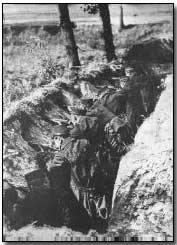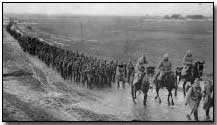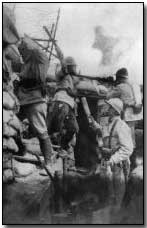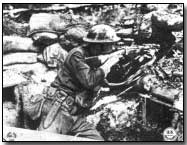Weapons of War - Rifles
 Despite advances in machine gun, mortar
and grenade technology, all remained relatively unwieldy and cumbersome in
comparison to the rifle, which remained the most crucial, ever-present
infantry weapon throughout World War One.
Despite advances in machine gun, mortar
and grenade technology, all remained relatively unwieldy and cumbersome in
comparison to the rifle, which remained the most crucial, ever-present
infantry weapon throughout World War One.
The Number One Infantry Weapon
The difficulty with these former weapons were their unwieldiness. While the infantry moved forward during a raid or attack the machine gun invariably proved impractical, both in terms of managing the machine gun itself but as much for the weight of the rounds of ammunition required to keep it serviceable.
As for the mortar, the fact that it was a one-shot weapon reduced its effectiveness. Grenades certainly had their role during a raid, but carrying buckets of supplies quickly proved tiring, and supplies generally ran out quite quickly.
Which left the pistol and the rifle, both key weapons on the battlefield, although the former was used less as an offensive weapon than the rifle, and were generally issued to officers rather than regular soldiery.
Late 19th Century Development
The single-shot, bigger-bore rifle was the subject of extensive research and development in the latter portion of the nineteenth century, with the result that the major powers introduced new models that were small-bore, bolt-action weapons capable of firing multiple rounds from a spring-loaded clip inserted into a rifle magazine.
 Curiously, despite the
intense interest in enhancing rifle capabilities in the years immediately
preceding World War One no real developments were introduced during the
actual war years - when ordinarily the reverse would be expected to be the
case.
Curiously, despite the
intense interest in enhancing rifle capabilities in the years immediately
preceding World War One no real developments were introduced during the
actual war years - when ordinarily the reverse would be expected to be the
case.
Rather, the key armies were chiefly concerned with ensuring that manufacturing of existing (adequate) models was kept at a high pitch. Research and development tended to be dedicated to other areas such as artillery, mortars, grenades and poison gases.
Rifle Performance
Although magazine design was clearly a factor in determining rifle performance, a greater impact was dependent upon the training and skill of the rifle operator himself. (Note that the advent of automatic and semiautomatic weapons waited until the last year of the war and beyond.)
 Much has been made of the
15 rounds per minute achieved at
Mons by
riflemen of the British Expeditionary Force. However these were highly
trained soldiers of what was then (August 1914) a professional army.
Much has been made of the
15 rounds per minute achieved at
Mons by
riflemen of the British Expeditionary Force. However these were highly
trained soldiers of what was then (August 1914) a professional army.
The flood of entrants to the New Armies - of all nations - could not hope to achieve such a sustained accurate rate of fire. The norm was perhaps eight to twelve rounds per minute.
In terms of range, the average during the war was around 1,400 metres, although accuracy could only be guaranteed at around 600 metres.
Sniper's Friend
The infantry aside, the rifle was a crucial element of the sniper's armoury: along with a human observer, that is.
Sniping as a military practice had proved its worth through the ages, but it was given an added importance in conditions of trench warfare.
Working day and night, trained marksmen would function essentially as assassins, often targeting any moving object behind enemy lines, even if they were engaged in peaceable tasks (which meant that if a sniper was taken prisoner he could expect no mercy, on either side).
 Snipers
were by no means specific to the Western Front; their talents were employed
on all fronts, including Gallipoli, Italy and Africa.
Snipers
were by no means specific to the Western Front; their talents were employed
on all fronts, including Gallipoli, Italy and Africa.
Although the overall number of casualties claimed by snipers were small (although many snipers kept count of their number of 'kills', often reaching triple figures), they played an important role in sapping enemy morale.
Soldiers knew that they could not walk about freely along exposed trenches; anyone unwise enough to peep above the front line parapet could expect a well-aimed bullet in the head - as often happened.
The types of rifles used by snipers varied, and included the Lee-Enfield on the British side and, on the German, wide usage of the Mauser rifle, whose fitted optical sight rendered it ideal for the purpose.
Rifle Models
Given the relentlessly high demand for any and all forms of offensive weaponry during the war - particularly during its earliest days when armament production was only beginning to accelerate - many different types of rifle were pressed into service, including a fair number of ancient models.
However for the most part a core set of models were relied upon by the key belligerent armies.
German Mauser
 The standard weapon in the
German army, the 7.92 mm Mauser Gewehr 98 was designed (as its name
suggests) in 1898 by Peter Paul Mauser (1838-1914). Somewhat superior
in design to the majority of its contemporaries, it incorporated the clip
and magazine into a single detachable mechanism, saving valuable loading
time.
The standard weapon in the
German army, the 7.92 mm Mauser Gewehr 98 was designed (as its name
suggests) in 1898 by Peter Paul Mauser (1838-1914). Somewhat superior
in design to the majority of its contemporaries, it incorporated the clip
and magazine into a single detachable mechanism, saving valuable loading
time.
It suffered however from the disadvantage of being unsuited to rapid fire (on account of its bolt arrangement), and was limited by a five-cartridge magazine.
Nevertheless it was a thoroughly dependable, well tested and accurate weapon, and with its fitted optical sight, ideal for use in sniping.
British Lee-Enfield
 Rivalling the Mauser both
in terms of use and reputation was the British Lee-Enfield 0.303-inch rifle,
which was issued to virtually all British soldiers on the Western Front (and
many elsewhere). First produced in 1907 and
officially titled the Short Magazine Lee-Enfield (SMLE) Mark III, the name
was derived from its designer (James Lee, an American) and its manufacturer
(the Royal Small Arms Factory based in Enfield, London).
Rivalling the Mauser both
in terms of use and reputation was the British Lee-Enfield 0.303-inch rifle,
which was issued to virtually all British soldiers on the Western Front (and
many elsewhere). First produced in 1907 and
officially titled the Short Magazine Lee-Enfield (SMLE) Mark III, the name
was derived from its designer (James Lee, an American) and its manufacturer
(the Royal Small Arms Factory based in Enfield, London).
Unlike the Mauser the Lee-Enfield, with its ten-cartridge magazine, was well suited to rapid fire; a suitably trained soldier could expect to fire twelve well-aimed shots a minute.
The Lee-Enfield proved so sturdy and reliable that its use continued into World War Two. Its design was also incorporated into both U.S. and Canadian models.
French Lebel
 Just as the Germans adopted
the Mauser and the British the Lee-Enfield, so the French opted for the
Lebel 8 mm weapon (officially titled the Fusil modele, produced in 1886, and
which unusually fired smokeless cartridges) as their rifle of choice during
the war years.
Just as the Germans adopted
the Mauser and the British the Lee-Enfield, so the French opted for the
Lebel 8 mm weapon (officially titled the Fusil modele, produced in 1886, and
which unusually fired smokeless cartridges) as their rifle of choice during
the war years.
Despite its wide use it suffered from a marked practical design flaw. Its eight rounds were loaded, nose to tail fashion, in a tubular magazine placed under the barrel of the rifle. This resulted in slow loading since the operator had to be wary of one round hitting the primer of the cartridge in front, thereby causing a most unwelcome explosion.
Although a better French model, the Berthier (see below), was available from 1916, the Lebel - despite its flaws - continued to be standard issue.
French Berthier
 As indicated above, the
French discovered a serious practical defect in their standard issue Lebel
rifle. Thus, two years into the war, the Berthier was issued as an
improvement. Officially titled the Fusil
d'Infanterie Modele 1907, Transforme 1915, the replacement rifle was, like
the Lee-Enfield, clip loaded. The differences with the Lebel did not
stop there however. The rifle's sights were different as was its bolt
mechanism.
As indicated above, the
French discovered a serious practical defect in their standard issue Lebel
rifle. Thus, two years into the war, the Berthier was issued as an
improvement. Officially titled the Fusil
d'Infanterie Modele 1907, Transforme 1915, the replacement rifle was, like
the Lee-Enfield, clip loaded. The differences with the Lebel did not
stop there however. The rifle's sights were different as was its bolt
mechanism.
A fine weapon, the original Berthier (designed in 1907) nevertheless suffered, like its predecessor, from a design flaw - its magazine held only three rounds. A modified version, produced in 1915, increased this to five rounds. The result was the Fusil modele 1916, loaded from a six-round clip or charger.
Immediately popular demand was such that certain supplies of the model were produced in the U.S. by the Remington company.
Carbines
A carbine (i.e. short-barrelled) version of the Berthier was produced in 1916, titled the Mousqueton modele 1916. Carbines were generally preferred by all armies as being somewhat less unwieldy than longer barrelled rifles.
Indeed, the move towards carbine development was perhaps the only notable advance to rifle technology during the war, although other modifications for trench conditions were undertaken, including the fitting of periscopes and tripods.
U.S. Springfield
 The Springfield,
manufactured in the U.S. (at Springfield, Massachusetts), was the standard
wartime rifle of the U.S. army. It was reliable and produced in a
short-barrelled version for issue to the American Expeditionary
Force. In short supply however around half of U.S. soldiers in the
field were issued with the M1917 'American Enfield'.
The Springfield,
manufactured in the U.S. (at Springfield, Massachusetts), was the standard
wartime rifle of the U.S. army. It was reliable and produced in a
short-barrelled version for issue to the American Expeditionary
Force. In short supply however around half of U.S. soldiers in the
field were issued with the M1917 'American Enfield'.
The performance of the U.S. rifle was comparable to the British Lee-Enfield, and was also produced in a Mk1 automatic version. The Springfield utilised a licensed Mauser action. Derivatives of the Springfield remained in use until the Korean War.
Austro-Hungarian Steyr-Mannlicher
 Produced
in Budapest and Steyr (in Austria), and known as the Repetier Gewehr M95,
the standard issue rifle of the Austro-Hungarian army was first produced in
1895.
Produced
in Budapest and Steyr (in Austria), and known as the Repetier Gewehr M95,
the standard issue rifle of the Austro-Hungarian army was first produced in
1895.
Considered a strong design, the Repetier Gewehr M95 withstood a so-called torture test of firing 50,000 rounds through a single rifle without lubrication of any kind. It was consequently produced in huge quantities during the war.
At one stage during the war the Austro-Hungarian army gave consideration to using the German Mauser rifle in preference to the Steyr-Mannlicher, before concluding that it was inferior in design to their own weapon.
This model was also subsequently used in large quantities by the Italian army (as World War One reparations).
Click here to read an article on the Canadian Ross rifle.
Photograph of SMLE courtesy of GreatWarAZ.
Photographs courtesy of Photos of the Great War website
A "creeping barrage" is an artillery bombardment in which a 'curtain' of artillery fire moves toward the enemy ahead of the advancing troops and at the same speed as the troops.
- Did you know?
